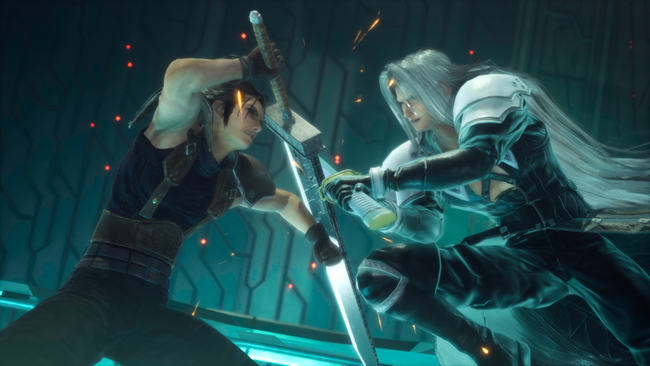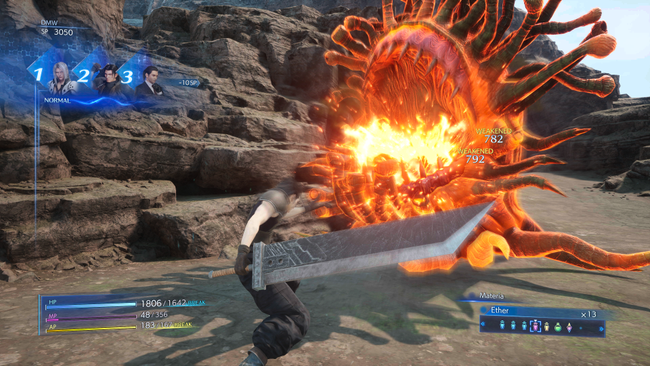Crisis Core Reunion’s DMW slots changes are a huge improvement - except for in one iconic scene
One of the most significant of the many changes in Crisis Core: Final Fantasy VII Reunion is the fact that the game’s DMW system has had a semi-significant presentational overhaul. It’s a huge improvement - except for in one crucial moment.
For those who aren’t closely following the various mechanic names, the DMW is the Digital Mind Wave - the silly in-universe title for what is essentially a slot machine that sits in the top left of every combat scene in Crisis Core, constantly spinning and doling out random bonuses to protagonist Zack Fair.
A mixed slots-style reel of the faces of the significant people in Zack’s life and a selection of numbers, the DMW dominates every aspect of Crisis Core so long as you don’t have the Cursed Ring equipped. It controls when Zack levels up; it powers up his materia - it even determines when he can use Limit Breaks and summons.

In the PSP version of Crisis Core, the DMW is a bloody nuisance. It’s important to the game, but it’s also constantly interrupting you, essentially pausing combat to make you watch a slot machine spin - but without any of the thrill of actually having the chance of winning any money. I’ve always found it to be a pretty miserable mechanic, and a relative blight on Crisis Core, which is a pretty strong FF spin-off.
Crisis Core Reunion aims to fix all of that by streamlining the DMW. It’s still forever reeling away in the background during combat, but it seldom interrupts you now, only flashing up full-screen when you occasionally unlock one of Zack’s memories about one of his friends. Even that is skippable.
Crisis Core is better for it. Except in one crucial instance.

At the end of Crisis Core, Zack dies. Anybody who has played the original Final Fantasy VII will know this. In Crisis Core, the events depicted in an optional scene in FF7 are fleshed out with surprising brutality. And the DMW plays a role.
In both versions, as Zack makes his last stand, the DMW keeps spinning. The player keeps fighting. But as the odds Zack faces get steeper, and as the upbeat hero gets weaker, the faces of his friends on the DMW begin to slowly disappear - taking the buffs they can offer when they appear on the reels with them. Thus, Zack’s odds get steeper.
The story implication is brutal - as Zack’s life slips away from him, he possibly struggles to remember his friends. They even sort of disappear from the DMW in an order of importance to him - until, at the end of his fight, only one person remains. Aerith, the young woman that the game is keen to showcase as Zack’s one true love - and he hers.
Story and mechanics in games often struggle to mesh together properly. But this section of Crisis Core is one of those perfect moments where narrative and mechanic align into something beautiful. It’s effective - and affecting - watching this system that has rolled away all game slowly break down as Zack’s body does.
Eventually, as Zack is riddled with bullets, he lies motionless. But those reels keep spinning, with only one character remaining - Aerith, the only person he can think of as he dies. And then she disappears too. Finally, so too does Zack, dying bloodied and defeated, barely about to anoint Cloud his successor.
This sequence is good in both games. But I actually think it’s slightly worse in Crisis Core Reunion. The DMW is more subdued now - it no longer takes over the game in full screen, feels to have less of a dominating presence on larger displays anyway, and the voice-over announcing ‘Modulating Phase’ has been removed. It’s streamlined, part of a general overhaul to give this the snappier, quicker, more free-flowing feel of an action game.
Playing the game itself, I accepted the changes as better and never looked back. I only really began to consider them once I reached the ending.
Take the Modulating Phase announcement, for instance. That voiceover was actually a bit annoying in the PSP original, owing to how ubiquitous it was. But it actually might be the thing I miss the most. But hearing ‘Modulating Phase’ accompanied by a telltale ‘powering up’ sound effect was also always exciting - it meant a buff was incoming. It could mean a bad battle could be turned around.
That made it all the more effective in the finale; when it interrupts you as Zack lays dying, even someone who knows how this story ends might feel momentary hope. In the silence of Zack’s defeat, the voice rings out - ‘MODULATING PHASE!’ Even when you know the story, one can’t help but think – here comes the buff, Aerith’s healing buff, that will restore Zack to health. But then Aerith begins to fade from his mind as Zack himself fades… and then she’s gone. It’s over. He’s over.
In Crisis Core Reunion, the loss of that voice and the general changes to the DMW in general render the final scenes ever so slightly less effective than they were back on the PSP. The DMW is less in your face - improving the rest of the game, but at the detriment of this iconic moment. The timings of the scene have been left identical, which means the final moments appear to linger on a dying Zack in silence for a beat too long - that beat previously filled by the voiceover and UI popping up. It all still works tremendously well - but it’s just a subtle difference that somehow has a greater effect than I ever could’ve imagined.
And yet, it’s a worthy change. The rest of Crisis Core is better for it. But as many fans are pondering why there's not a new Remake-style Secret Ending, and probably forever more when I think of this game I'll instead always think about how it looked - and felt - on PSP.